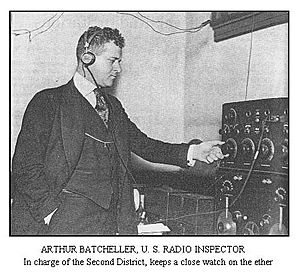Arthur Batcheller facts for kids
Arthur Batcheller (born March 21, 1888 – died March 7, 1978) was an important person in the early days of radio. He helped start the Massachusetts Radio Telegraph School. He also worked as a Radio Inspector for the U.S. government.
In 1920, Herbert Hoover, who was then the Secretary of Commerce, made Batcheller the Chief Radio Inspector for the New York area. Later, in 1930, he became the Traveling Supervisor of Radio. This was a very important job in radio at the time.
Contents
Arthur Batcheller's Early Life and School
Arthur Batcheller was born on March 21, 1888, in Wellesley, Massachusetts. He went to the Boston School of Telegraphy in 1902.
While working as a locomotive fireman for a railroad, he studied electronics. He attended the Boston YMCA Electrical Engineering School. After that, he went to the Boston YMCA Polytechnic School. In 1913, he earned his First Class Radio Operators license. This license allowed him to operate advanced radio equipment.
Arthur Batcheller's Career in Radio
In 1906, Arthur Batcheller started working for the Boston, Revere Beach and Lynn Railroad. He was a locomotive fireman. After finishing his electronics studies, he returned to the railroad. He became the assistant chief electrician.
In 1914, Batcheller left the railroad. He joined the Eastern Steamship Corporation as chief electrician until 1916. Then, he worked for the American Steam, Gauge and Valve Manufacturing Company.
Radio Inspector During World War I
During World War I, Batcheller was appointed Radio Inspector for Boston. He held this job until late 1918. As a Radio Inspector, he had special permission. He could go onto German ships in Boston Harbor. His job was to seal off their radio equipment. This prevented them from sending messages.
In 1917, Batcheller got permission from the U.S. government. He opened the First United States Government Free Radio School. This school trained people to be wireless and radio operators for the military. It opened on July 23, 1917, in the Boston Custom House. Fifty students were in the first class. The school trained over one thousand men. It operated from June 1917 to November 1918. When World War I ended with the Armistice, the school closed.
Chief Radio Inspector in New York
In 1919, Batcheller helped start the Massachusetts Radio and Telegraph School. In 1920, Herbert Hoover appointed him Chief Radio Inspector. Hoover was the Secretary of Commerce at the time. Batcheller was in charge of radio communication for the port of New York.
He also served as a Technical Adviser for the U.S. delegation. This was for the 1927 International Radio Telegraph Conference.
Batcheller is known for a disagreement with Lee de Forest. De Forest was an inventor called the "Father of Radio." In 1920, De Forest moved his experimental radio station, Radio 2XG, without government approval. Batcheller, as the U.S. Radio Inspector, shut down De Forest's station.
In 1923, Batcheller organized a meeting in New York. It was for local radio broadcasters. He explained how radio stations were classified. He also encouraged them to work together on their broadcast schedules. Representatives from major stations like WEAF (now WNBC) and WOR attended.
Later Roles in Radio Service
In 1930, President Hoover gave Batcheller a new job. He became the Traveling Supervisor of Radio. This was the highest field position in radio service then. When the Federal Communications Commission (FCC) was created in 1932, Batcheller became Supervisor of Radio for the New York district.
Batcheller also helped with radio investigations. These included cases about shipwrecks and radio agreements. He also worked on cases involving illegal radio operations. In the 1930s, he helped develop rules for licensing commercial radio networks.
Through his work, Batcheller became friends with important people. These included David Sarnoff, who received the Titanic distress call. He was also friends with Senator Guglielmo Marconi, a radio pioneer. He knew Mr. and Mrs. Charles Lindbergh, the famous aviators.
Arthur Batcheller was a lifelong member of the Radio Engineers club. He held positions on their board of directors. He also served on their admission, broadcast, and law committees.
Arthur Batcheller's Personal Life and Hobbies
Arthur Batcheller enjoyed photography and ballet. He was a freelance photographer in his free time. He was also a member of the Mt. Olivet Masonic Lodge in Cambridge. He belonged to the New York and London Ballet Clubs.
From 1920 to 1956, Batcheller lived in New York. He and his sister, Mabel, often went to ballet performances. They combined their love for photography and dance. They collected signed photos of famous dancers. They also collected autographed ballet slippers. Batcheller was also interested in movies. He collected many photographs of actresses, including Marilyn Monroe.
In 1956, Batcheller retired. He moved to Framingham, Massachusetts. There, he and his sister opened and managed his private museum.
Arthur Batcheller's Death
Arthur Batcheller passed away on March 7, 1978. He died at a nursing home in Framingham, Massachusetts.


